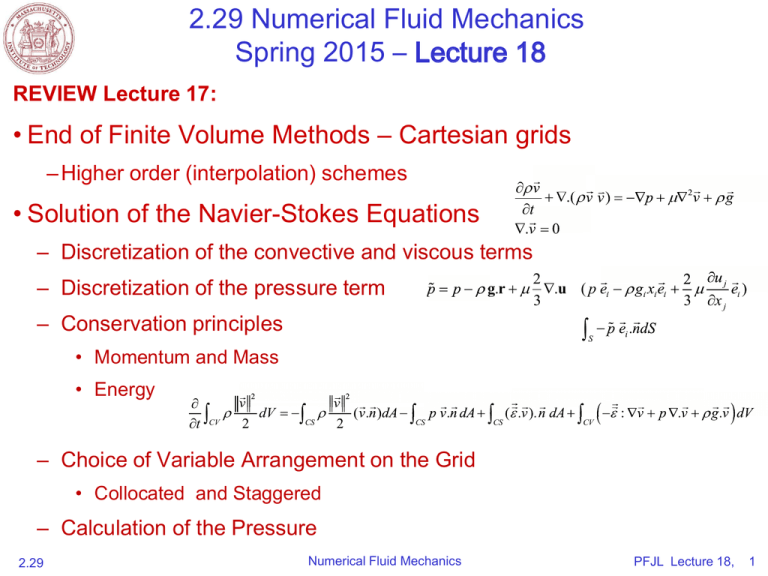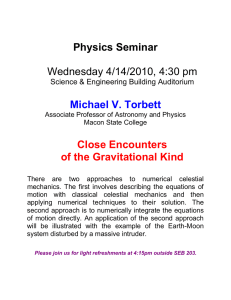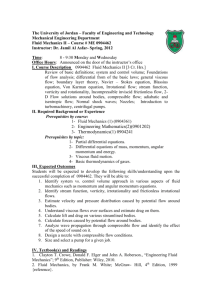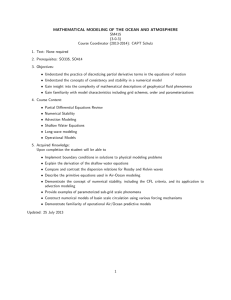
2.29 Numerical Fluid Mechanics
Spring 2015 – Lecture 18
REVIEW Lecture 17:
• End of Finite Volume Methods – Cartesian grids
– Higher order (interpolation) schemes
• Solution of the Navier-Stokes Equations
v
.( v v ) p 2v g
t
0
.v
– Discretization of the convective and viscous terms
– Discretization of the pressure term
– Conservation principles
2
2 u
p p g.r .u ( p ei gi xi ei j ei )
3
3 x j
S
p ei .ndS
• Momentum and Mass
• Energy
2
2
v
v
(v .n )dA p v .n dA ( .v ). n dA : v p .v g.v dV
dV
CS
CS
CS
CV
2
2
t CV
– Choice of Variable Arrangement on the Grid
• Collocated and Staggered
– Calculation of the Pressure
2.29
Numerical Fluid Mechanics
PFJL Lecture 18,
1
TODAY (Lecture 18):
Numerical Methods for the Navier-Stokes Equations
• Solution of the Navier-Stokes Equations
–
–
–
–
–
–
Discretization of the convective and viscous terms
Discretization of the pressure term
Conservation principles
Choice of Variable Arrangement on the Grid
Calculation of the Pressure
Pressure Correction Methods
• A Simple Explicit Scheme
• A Simple Implicit Scheme
– Nonlinear solvers, Linearized solvers and ADI solvers
• Implicit Pressure Correction Schemes for steady problems
– Outer and Inner iterations
• Projection Methods
– Non-Incremental and Incremental Schemes
• Fractional Step Methods:
– Example using Crank-Nicholson
2.29
Numerical Fluid Mechanics
PFJL Lecture 18,
2
References and Reading Assignments
• Chapter 7 on “Incompressible Navier-Stokes equations” of
“J. H. Ferziger and M. Peric, Computational Methods for
Fluid Dynamics. Springer, NY, 3rd edition, 2002”
• Chapter 11 on “Incompressible Navier-Stokes Equations” of
T. Cebeci, J. P. Shao, F. Kafyeke and E. Laurendeau,
Computational Fluid Dynamics for Engineers. Springer,
2005.
• Chapter 17 on “Incompressible Viscous Flows” of Fletcher,
Computational Techniques for Fluid Dynamics. Springer,
2003.
2.29
Numerical Fluid Mechanics
PFJL Lecture 18,
3
Calculation of the Pressure
• The Navier-Stokes equations do not have an independent
equation for pressure
– But the pressure gradient contributes to each of the three momentum
equations
– For incompressible fluids, mass conservation becomes a kinematic
constraint on the velocity field: we then have no dynamic equations for
both density and pressure
– For compressible fluids, mass conservation is a dynamic equation for
density
• Pressure can then be computed from density using an equation of state
• For incompressible flows (or low Mach numbers), density is not a state
variable, hence can’t be solved for
• For incompressible flows:
– Momentum equations lead to the velocities
– Continuity equation should lead to the pressure, but it does not
contain pressure! How can p be estimated?
2.29
Numerical Fluid Mechanics
PFJL Lecture 18,
4
Calculation of the Pressure
• Navier-Stokes, incompressible:
v
.( v v ) p 2v g
t
0
.v
• Combine the two conservation eqs. to obtain an equation for p
– Since the cons. of mass has a divergence form, take the divergence of the
momentum equation, using cons. of mass:
• For constant viscosity and density:
.p 2 p .
v
. .( v v ) . 2v . g . .( v v )
t
– This pressure equation is elliptic (Poisson eqn. once velocity is known)
• It can be solved by methods we have seen earlier for elliptic equations
– Important Notes
p
ui u j
xi xi
xi x j
• RHS: Terms inside divergence (derivatives of momentum terms) must be approximated in a
form consistent with that of momentum eqns. However, divergence is that of cons. of mass.
• Laplacian operator comes from i) divergence of cons. of mass and ii) gradient in momentum
eqns.: consistency must be maintained, i.e. divergence and gradient discrete operators in
Laplacian should be those of the cons. of mass and of the momentum eqns., respectively
• Best to derive pressure equation from discretized momentum/continuity equations
2.29
Numerical Fluid Mechanics
PFJL Lecture 18,
5
Pressure-correction Methods
• First solve the momentum equations to obtain the velocity
field for a known pressure
• Then solve the Poisson equation to obtain an
updated/corrected pressure field
• Another way: modify the continuity equation so that it
becomes hyperbolic (even though it is elliptic)
– Artificial Compressibility Methods
• Notes:
– The general pressure-correction method is independent of the
discretization chosen for the spatial derivatives in theory any
discretization can be used
– We keep density in the equations (flows are assumed
incompressible, but small density variations are considered)
2.29
Numerical Fluid Mechanics
PFJL Lecture 18,
6
A Simple Explicit Time Advancing Scheme
• Simple method to illustrate how the numerical Poisson
equation for the pressure is constructed and the role it plays in
enforcing continuity
• Specifics of spatial derivative scheme not important, hence, we
look at the equation discretized in space, but not in time.
– Use
xi
to denote discrete spatial derivatives.
This gives: ui ( ui u j ) p + ij ui ( ui u j ) p + ij H i p
t
x j
Note: p preal gi xi
xi
x j
t
xj
xi
xj
xi
– Simplest approach: Forward Euler for time integration, which gives:
ui
n 1
ui
n
n pn
t H i
x
i
• In general, the new velocity field we obtain at time n+1 does not satisfy the
discrete continuity equation:
n 1
ui
0
xi
2.29
Numerical Fluid Mechanics
PFJL Lecture 18,
7
A Simple Explicit Time Advancing Scheme
• How can we enforce continuity at n+1?
• Take the discrete numerical divergence of the NS eqs.:
ui
n 1
ui
n
n pn
t H i
x
i
ui
xi
n 1
n p n
ui
t
Hi
xi
xi
x
i
n
– The first term is the divergence of the new velocity field, which we want to
be zero, so we set it to zero.
– Second term is zero if continuity was enforced at time step n
– Third term can be zero or not, but the two above conditions set it to zero
• All together, we obtain:
p n Hin
xi xi xi
– Note that this includes the divergence operator from the continuity eqn.
(outside) and the pressure gradient from the momentum equation (inside)
– Pressure gradient could be explicit (n) or implicit (n+1)
2.29
Numerical Fluid Mechanics
PFJL Lecture 18,
8
A Simple Explicit Time Advancing Scheme:
Summary of the Algorithm
• Start with velocity at time tn which is divergence free
• Compute RHS of pressure equation at time tn
• Solve the Poisson equation for the pressure at time tn
• Compute the velocity field at the new time step using the
momentum equation: It will be discretely divergence free
• Continue to next time step
2.29
Numerical Fluid Mechanics
PFJL Lecture 18,
9
A Simple Implicit Time Advancing Scheme
• Some additional difficulties arise when an implicit method is
used to solve the (incompressible) NS equations
• To illustrate, let’s first try the simplest: backward/implicit Euler
( ui u j ) p ij
ui
p
Hi
+
t
xj
xi x j
xi
– Recall:
– Implicit Euler:
ui
n 1
ui
n
( ui u j ) n 1 ij n 1 p n 1
n 1 p n 1
t H i
+
t
x
x
x
x
i
j
j
i
• Difficulties (specifics for incompressible case)
1) Set numerical divergence of velocity field at new time-step to be zero
• Take divergence of momentum, assume velocity is divergence-free at time tn
and demand zero divergence at tn+1. This leads to:
ui
xi
n 1
n 1 p n 1
ui
p n 1 ( ui u j )
t
Hi
xi
x
x
x
x
x
xj
i
i
i
i
i
n
n 1
ij n 1
x j
• Problem: The RHS can not be computed until velocities are known at tn+1 (and
these velocities can not be computed until pn+1 is available)
• Result: Poisson and momentum equations have to be solved simultaneously
2.29
Numerical Fluid Mechanics
PFJL Lecture 18,
10
A Simple Implicit Time Advancing Scheme, Cont’d
2) Even if pn+1 known, a large system of nonlinear momentum
equations must be solved for the velocity field:
ui
n 1
ui
Three approaches for solution:
n
( ui u j ) n 1 ij n 1 p n 1
t
+
x
x
x
j
j
i
– First approach: nonlinear solvers
• Use velocities at tn for initial guess of ui n+1 (or use explicit-scheme as first
guess) and then employ a nonlinear solver (Fixed-point, Newton-Raphson or
Secant methods) at each time step
• Nonlinear solver is applied to the nonlinear algebraic equations
ui
n 1
ui
n
( ui u j ) n 1 ij n 1 p n 1
t
+
x
x
x
j
j
i
p n 1 ( ui u j )
xi xi xi
xj
2.29
n 1
Numerical Fluid Mechanics
ij n 1
x j
PFJL Lecture 18,
11
A Simple Implicit Time Advancing Scheme, Cont’d
– Second approach: linearize the equations about the result at tn
uin 1 uin ui
uin 1 u nj 1 uin u nj uin u j u nj ui ui u j
• We’d expect the last term to be of 2nd order in Δt, it can thus be neglected (for a
2nd order in time, e.g. C-N scheme, it would still be of same order as spatial
discretization error, so can still be neglected).
• Hence, doing the same in the other terms, the (incompressible) momentum
equations are then approximated by:
ui
n 1
ui
n
( ui u j ) n ( uin u j ) ( ui u nj ) ij n ij p n p
ui t
x
x
x
x
x
x
x
j
j
j
j
j
i
i
• One then solves for Δui and Δp (using the above mom. eqn. and its Δp eqn.)
• This linearization takes advantage of the fact that the nonlinear term is only
quadratic
• However, a large coupled linear system (Δui & Δp) still needs to be inverted.
Direct solution is not recommended: use an iterative scheme
– A third interesting solution scheme: an Alternate Direction Implicit scheme
2.29
Numerical Fluid Mechanics
PFJL Lecture 18,
12
Parabolic PDEs: Two spatial dimensions
ADI scheme (Two Half steps in time)
(from Lecture 14)
t
© McGraw-Hill. All rights reserved. This content is excluded from our Creative Commons license. For more information, see http://ocw.mit.edu/fairuse.
Source: Chapra, S., and R. Canale. Numerical Methods for Engineers. McGraw-Hill, 2005.
1) From time n to n+1/2: Approximation of 2nd order x derivative is explicit,
while the y derivative is implicit. Hence, tri-diagonal matrix to be solved:
Ti ,nj1/ 2 Ti ,nj
t / 2
c
n
n
n
T
2
T
T
i
1,
j
i
,
j
i
1, j
2
x
2
c
n 1/ 2
n 1/ 2
n 1/ 2
T
2
T
T
i
,
j
1
i
,
j
i
,
j 1
2
y
2
O(x
2
y 2 )
2) From time n+1/2 to n+1: Approximation of 2nd order x derivative is implicit,
while the y derivative is explicit. Another tri-diagonal matrix to be solved:
Ti ,nj1 Ti ,nj1/ 2
t / 2
2.29
c
2
Ti n1,1j 2Ti ,nj1 Ti n1,1j
x
2
c
2
Ti ,nj1/1 2 2Ti ,nj1/ 2 Ti ,nj1/1 2
Numerical Fluid Mechanics
y
2
O(x
2
y 2 )
PFJL Lecture 18,
13
Parabolic PDEs: Two spatial dimensions
ADI scheme (Two Half steps in time)
i=1
i=2
i=3
i=1
i=2
(from Lecture 14)
i=3
j=3
j=2
j=1
First direction
y
x
For Δx=Δy:
The ADI method applied along the y direction and x direction.
This method only yields tridiagonal equations if applied along
the implicit dimension.
Image by MIT OpenCourseWare. After Chapra, S., and R. Canale. Numerical Methods for Engineers. McGraw-Hill, 2005.
1) From time n to n+1/2:
(1st tri-diagonal sys.)
2) From time n+1/2 to n+1:
(2nd tri-diagonal sys.)
2.29
Second direction
rTi ,nj1/1 2 2(1 r )Ti ,nj1/ 2 rTi ,nj1/1 2 rTi n1, j 2(1 r)Ti ,nj rTi n1, j
rTi n1,1j 2(1 r )Ti ,nj1 rTi n1,1j rTi ,nj1/1 2 2(1 r)Ti ,nj1/ 2 rTi ,nj1/1 2
Numerical Fluid Mechanics
PFJL Lecture 18,
14
A Simple Implicit Time Advancing Scheme, Cont’d
• Alternate Direction Implicit method
– Split the NS momentum equations into a series of 1D problems, e.g. each
being block tri-diagonal. Then, either:
– ADI nonlinear: iterate for the nonlinear terms, or,
– ADI with a local linearization:
• Δp can first be set to zero to obtain a new velocity ui* which does not satisfy
continuity:
( ui u j ) n ( uin u j ) ( ui u nj ) ij n ij p n
n
* n 1
ui ui t
xj
xj
xj
xj
xj
xi
• Solve a Poisson equation for the pressure correction. Taking the divergence of:
( ui u j ) n ( uin u j ) n ( ui u nj ) n ij n ij p n p
ui ui t
xj
xj
xj
xj
x j xi
xi
n 1
p
n 1
ui ui * t
xi
n 1
n
p 1 ( ui * ) n 1
gives,
, from which Δp can be solved for.
xi xi t
xi
n 1
* n 1
u
u
i t xp
• Finally, update the velocity: i
i
2.29
Numerical Fluid Mechanics
PFJL Lecture 18,
15
Methods for solving (steady) NS problems:
Implicit Pressure-Correction Methods
• Simple implicit approach based on linearization is most useful
for unsteady problems (with limited time-steps)
– It is not accurate for large (time) steps (because the linearization would
then lead to a large error)
– Thus, it should not be used for steady problems (which often use large
time-steps)
• Steady problems are often solved with an implicit method (with
pseudo-time), but with large time steps (no need to reproduce
the pseudo-time history)
– The aim is to rapidly converge to the steady nonlinear solution
• Many steady-state solvers are based on variations of the implicit
schemes
– They use a pressure (or pressure-correction) equation to enforce
continuity at each “pseudo-time” steps, also called “outer iteration”
2.29
Numerical Fluid Mechanics
PFJL Lecture 18,
16
Methods for solving (steady) NS problems:
Implicit Pressure-Correction Methods, Cont’d
• For a fully implicit scheme, the steady state momentum equations are:
ui
n 1
ui
n
( ui u j ) n 1 ij n 1 p n 1
0
+
0
x
x
x
j
j
i
• With the discretized matrix notation, the result is a nonlinear algebraic system
A
uin 1
u
n 1
i
b
n 1
ui
δp
δxi
n 1
– The b term in the RHS contains all terms that are explicit (in uin) or linear in uin+1 or
that are coefficients function of other variables at tn+1, e.g. temperature
– Pressure gradient is still written in symbolic matrix difference form to indicate that
any spatial derivatives can be used
– The algebraic system is nonlinear. Again, nonlinear iterative solvers can be used.
For steady flows, the tolerance of the convergence of these nonlinear-solver
iterations does not need to be as strict as for a true time-marching scheme
– Note two types of successive iterations can be employed with pressure-correction:
• Outer iterations: (over n one
pseudo-time step) use nonlinear solvers which update the
ui 1
elements of matrix A as well as uin 1 (uses no or approx. pressure term, then corrects it)
• Inner Iterations: linear algebra to solve the linearized system with fixed coefficients
2.29
Numerical Fluid Mechanics
PFJL Lecture 18,
17
Methods for solving (steady) NS problems:
Implicit Pressure-Correction Methods, Cont’d
• Outer iteration m (pseudo-time): nonlinear solvers which update the elements
best estimate of exact u without any p-grad.
of the matrix A u as well as uim* :
m*
i
m 1
m 1
m 1
1
1 δ p
1 δ p
δp
uim*
uim*
uim*
m*
m 1
m*
A u
b
b u m* A
formally, ui A
ui A
i
δxi
δxi
δxi
– The resulting velocities uim* do not satisfy continuity (hence the *) since the RHS is
m*
obtained from pm-1 at the end of the previous outer iteration → needs to correct ui .
m
m
m
δ
p
δ
u
m
u
m
m
i
– The final ui needs to satisfy: A i u
b um
and
0
i
i
δ
δ
x
x
i
i
1
1 δp m
uim
uim
m
m 1
ui
A
b um A
i
δxi
m
δ uim* δ uim* 1 δp
0
m
A
1
m * 1 δ p
uim*
u
m 1
δ
δ
δ
x
x
x
i
i
i
i
b u m* A
A
i
δxi
uim*
m*
i
m 1
uim*
• Inner iteration: After solving a Poisson equation
m
δp
u
m
m
A
ui b u
for the pressure, the final velocity is calculated
δxi
using the inner iteration (fixed coefficient A)
• Finally, increase m to m+1 and iterate (outer, then inner)
m*
i
m*
i
This scheme is a variation of previous time-marching schemes. Main differences: i) no
time-variation terms, and, ii) the terms in RHS can be explicit or implicit in outer iteration.
2.29
Numerical Fluid Mechanics
PFJL Lecture 18,
18
Methods for solving (steady) NS problems:
Projection Methods
• These schemes that first construct a velocity field that does not
satisfy continuity, but then correct it using a pressure gradient
are called “projection methods”:
– The divergence producing part of the velocity is “projected out”
• One of the most common methods of this type are the pressurecorrection schemes
– Substitute uim uim* u ' and pm pm1 p ' in the previous equations
– Variations of these pressure-correction methods include:
• SIMPLE (Semi-Implicit Method for Pressure-Linked Equations) method:
– Neglects contributions of u’ in the pressure equation
• SIMPLEC: approximate u’ in the pressure equation as a function of p’ (better)
• SIMPLER and PISO methods: iterate to obtain u’
– There are many other variations of these methods: all are based on outer
and inner iterations until convergence at m (n+1) is achieved.
2.29
Numerical Fluid Mechanics
PFJL Lecture 18,
19
Projection Methods: Example Scheme 1
Guermond et al, CM-AME-2006
Non-Incremental (Chorin, 1968):
No pressure term used in predictor momentum equation
Correct pressure based on continuity
Update velocity using corrected pressure in momentum equation
ui
* n 1
ui
n 1
ui
ui
ui
2.29
ui
( ui u j ) n 1 ij n 1
t
+
;
xj
xj
* n 1
ui
xi
n 1
n
p n 1
t
xi
n 1
* n 1
ui*
0
p n 1
t
xi
p n 1 1
xi xi t xi
n 1
D
(bc)
u
* n 1
i
;
p n 1
0
n D
Note: advection term can be treated:
- implicitly for u* at n+1 (need to
iterate then), or,
- explicitly (evaluated with u at n),
as in 2d FV code and many others
Numerical Fluid Mechanics
PFJL Lecture 18,
20
Projection Methods: Example Scheme 2
Guermond et al, CM-AME-2006
Incremental (Goda, 1979):
Old pressure term used in predictor momentum equation
Correct pressure based on continuity: pn1 pn p '
Update velocity using pressure increment in momentum equation
u
* n 1
i
ui
n 1
ui
ui
n
( ui u j ) n 1 ij n 1 p n
t
+
;
x
x
x
j
j
i
* n 1
ui
xi
ui
2.29
n 1
ui
* n 1
t
p n 1 p n
xi
n 1
0
t
u
p n 1 p n
xi
* n 1
i
D
n 1
n
p p 1
t xi
x
x
i
i
(bc)
u ;
* n 1
i
p n 1 p n
n
0
D
Notes:
- this scheme assumes u’=0 in the pressure equation.
It is as the SIMPLE method, but without the iterations
- As for the non-incremental scheme, the advection
term can be explicit or implicit
Numerical Fluid Mechanics
PFJL Lecture 18,
21
Projection Methods: Example Scheme 3
Guermond et al, CM-AME-2006
Rotational Incremental (Timmermans et al, 1996):
Old pressure term used in predictor momentum equation
Correct pressure based on continuity: p n 1 p n p ' p n p n 1 f (u ')
Update velocity using pressure increment in momentum equation
u
* n 1
i
ui
n 1
ui
ui
n
( ui u j ) n 1 ij n 1 p n
t
+
;
x
x
x
j
j
i
* n 1
ui
xi
ui
n 1
ui
t
xi
n 1
* n 1
0
t
p n 1 p n p n 1
2.29
p n 1
p n 1
xi
xi
ui*
n 1
u
* n 1
i
n 1
p 1
t xi
xi xi
D
(bc)
u ;
* n 1
i
ui u j
x
x
i
j
ij n 1
p n 1
n
0
D
Notes:
- this scheme accounts for u’ in the pressure eqn.
- It can be made into a SIMPLE-like method, if iterations are added
- Again, the advection term can be explicit or implicit. The rotational
correction to the left assumes explicit advection
Numerical Fluid Mechanics
PFJL Lecture 18,
22
MIT OpenCourseWare
http://ocw.mit.edu
2.29 Numerical Fluid Mechanics
Spring 2015
For information about citing these materials or our Terms of Use, visit: http://ocw.mit.edu/terms.





